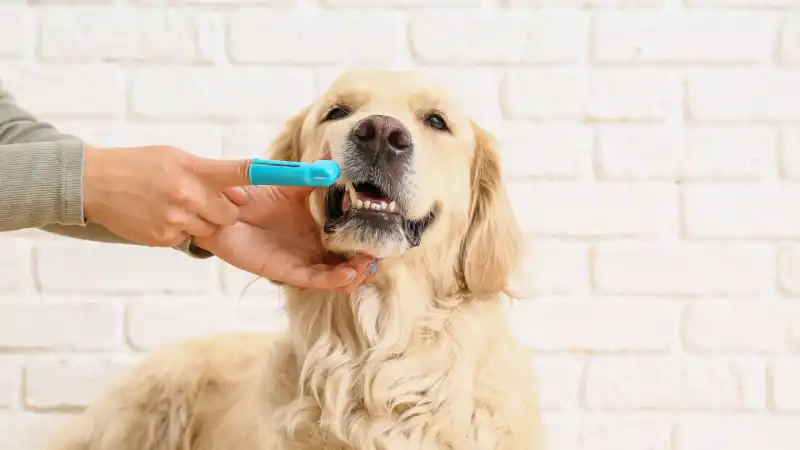Can Dogs Get Skin Cancer?
Do dogs get skin cancer? Sadly, dogs can get skin cancer in much the same way humans do. Learn the types of skin cancer and how to reduce the risks.

You protect your dog in the summer by ensuring they're hydrated, keeping them cool, and always watching them in the pool, but should you be doing more? Since your dog spends more time under the hot sun during the warmer months, you should also be protecting their skin.
Many pet owners are unaware that dogs can get skin cancer in much the same way humans do. While sun exposure does play a large role in the development of skin cancer, there are many other factors to consider.
Let's take a closer look at skin cancer in dogs.
Factors of Skin Cancer in Dogs
Sunlight
Direct sunlight is unlikely to cause cancer, but it does tip the scales and may increase cancer risks in some dogs. Short-haired or light-haired dogs don’t have much protection when they’re outside playing under the sun, and just like humans, the more time they spend under direct sunlight, the more likely they are to be overexposed to the sun's harmful rays.
However, that doesn’t mean that long-haired dogs aren’t at risk. Even dogs with a good coat of thick fur have places on their body that are less protected, such as their nose and belly, which are more exposed to UV rays than the rest of their bodies.
Genetics that Cause Cancer in Dogs
Genetics plays a role in determining if your dog will develop canine cancer of any kind, so do your research to determine if your dog’s breed or other genetic factors make them more susceptible.
If your dog is purebred, you may want to ask your breeder whether there is any cancer in the bloodline. Also, you can talk with a licensed veterinarian about the likelihood of skin cancer in your dog's breed.
Some dog breeds have higher cancer rates than others, including Boston Terriers, Boxers, Golden Retrievers, Schnauzers, and Scottish Terriers.
Compulsive Licking May Contribute to Dog Skin Cancer
It’s believed that compulsive licking in dogs may cause the cells of their affected skin to reproduce faster, which may increase the likelihood of cancer-causing mutations. If your dog is suffering from hotspots that are causing itchiness and irritation, consider using an oatmeal bath, cooling sprays, or other dog itch remedies to help reduce their need to lick.
Cancer-Causing Viruses in Dogs
Some viruses, such as the papillomavirus, can cause squamous cell carcinomas in dogs across a variety of breeds, sizes, and ages. Papillomavirus causes warts around the mouth of dogs and is transmitted through contact with infected saliva. Knowing this can help you determine if your dog may have such a virus -- if you notice warts or other skin irregularities around your dog's mouth or anywhere else on their snout, make an appointment with your veterinarian right away to rule out papillomavirus and other viruses.
Secondhand Smoke
It is well documented that smoking is bad for the human body, but secondhand smoke can also be dangerous for your pets, including dogs and cats. Secondhand smoke has been associated with oral squamous cell carcinoma in dogs. If you must smoke cigarettes, do so away from your dog in a well-ventilated outdoor area.

Every Dog and Cat Deserves the Pet Insurance of Champions
Get prize-winning care for your pets.
Types of Dog Skin Cancer
There are several different types of skin cancer that dogs can develop, though many share the same symptoms. The main types of skin cancer in dogs are melanomas, squamous cell carcinomas, basal cell tumors, and mast cell tumors.
Skin cancer often presents as a bump, so if you notice any new lumps on your dog's skin, you should contact your vet as soon as possible. Your vet will likely take a sample of your dog's skin with a fine needle aspirate, skin scraping, or by removing a portion of the tumor to review under a microscope. If it is cancer, this sample will allow your vet to determine the type and stage. The earlier cancer is detected, the better the chances are for effective treatment and recovery for canine patients.
Melanoma
Melanomas are common in dogs with darker-pigmented skin. They are usually dark in color (brown/black) and are solitary mole-like growths up to 2.5 inches in diameter. Malignant melanomas often occur on and around the lips, mouth, or nail beds, but they can occur anywhere that skin pigment occurs on the body. Some breeds, such as Vizslas, Miniature Schnauzers, Dobermans, Scottish Terriers, and Airedale Terriers, are more at risk for melanomas.
Squamous Cell Carcinoma
Squamous cell carcinomas have a firm, raised, wart-like appearance and are often located on the nose, ears, legs, or anus. However, any white-skinned area of a dog with little or no hair is also at an increased risk. Because of this, squamous cell carcinomas are more frequently found in breeds with short, thin, light-colored coats, such as Basset Hounds, Collies, Dalmatians, and Beagles.
Basal Cell Tumors
Basal cell tumors are one of the most common skin cancers in animals and account for 3 to 12% of all skin tumors in dogs. These tumors originate in one of the deepest skin layers, the basal epithelium, and often occur in older dogs. Malignant basal cell tumors, called basal cell carcinomas, appear as red, hairless, raised masses in the skin and are generally located on the head, neck, or shoulders. Some breeds that are more commonly known to develop basal cell tumors are Cocker Spaniels, Poodles, Kerry Blue Terriers, and Brussels Griffons.
Mast Cell Tumors
Mast cell tumors are one of the more common skin cancers found in dogs. They are visible, hairless lumps that often feel rubbery. Mast cells are responsible for the itching and redness that occurs in the skin when it encounters an allergen, so mast cell tumors tend to be red and itchy.
These tumors can appear as lumps or bumps that shrink or grow rapidly, so many pet owners believe the mass isn’t cancerous because it seems to “disappear” temporarily. It is believed that exposure to the sun does not play a role in the growth of mast cell tumors. Instead, they are primarily caused by genetics. Certain breeds such as Boxers, Boston Terriers, Labrador Retrievers, Pugs, and Golden Retrievers are predisposed to developing this type of tumor.
Early Detection of Skin Cancer in Dogs
Detecting cancer and getting an accurate diagnosis early will positively impact your pet's health. Early detection may prevent cancer from spreading to crucial internal organs. Dogs with light skin pigmentation are also at risk of many common types of skin cancer. Owners typically find skin cancer, especially melanoma of the skin and the toe (or toenail), by noticing tumors. Signs of skin cancer include:
Skin tumors or unusual lumps and bumps that look inflamed
Areas that are very dark-pigmented or dark in color
Any patch of skin with very little pigment, which is also called amelanotic
Raised warts that are firm to the touch
Treatment Options for Dog Skin Cancer
Treatment optionsmay vary based on the type of skin cancer, and tumors caught early are usually responsive to treatment. The treatment depends on both the type of tumor and its location. With that in mind, aggressive surgery is needed to remove the primary tumor and control the local disease. This is the case for melanomas. In some instances, surgery alone may cure the disease, but radiation therapy is also used to delay it from recurring at the surgery site. Chemotherapy may also be used in combination with radiation or surgery.
Provide Your Dog with Protection from the Sun
Sunlight is one factor in the development of skin cancer in canines and, luckily, it’s one of the easiest to protect against. Provide shaded areas for your dog to relax and play under in your yard. Plant trees or put up an umbrella or shade on your deck, so your dog can enjoy playing outside without being subjected to the sun’s direct rays. Keeping your dog indoors during the hottest part of the day is also helpful.
A dog-safe sunscreen is an option for the protection of areas of your dog’s body with less fur. Make sure that you use sunscreen that is specified as dog-safe -- human sunscreen can be harmful if your dog ingests it. Also, experts recommendchoosing a sunscreen for your dog without zinc or zinc oxide, which may damage a dog’s red blood cells. If your dog is outdoors during peak sun exposure hours from 10 a.m. to 4 p.m., reapply sunscreen to sensitive areas such as the nose, lips, ears, and belly.
Protective dog sun gear can be purchased if your dog is more susceptible to the sun. Many pet supply companies offer solar-protective shirts and visors. You can even buy your dog Doggles (dog sunglasses) to protect their eyes from the sun!
Safe for Summer!
By providing shade and applying sunscreen, you can help reduce the likelihood that your dog will develop skin cancer. Regardless of the season, vets explain that making a habit of checking your dog for new lumps every month can save their life. Little preventive measures can help ensure that your dog lives well into their golden years!
If your dog’s breed is more susceptible to skin cancer, you may want to consider a dog insurance policy that covers pre-existing conditions. AKC Pet Insurance (underwritten by Independence American Insurance Company) is the ONLY brand that offers pre-existing condition coverage for curable and incurable conditions after a 12-month waiting period*.

Every Dog and Cat Deserves the Pet Insurance of Champions
Get prize-winning care for your pets.
*Not available in all states. Pre-existing condition coverage requires a 12-month waiting period.****“Only brand“ refers to comparison with 5 pet insurance carriers making up approximately 80% of the US pet insurance market (Nationwide, ASPCA, Trupanion, HealthyPaws and PetPlan).

Mary comes to AKC Pet Insurance with an extensive background in animal care. As a lifelong animal lover, she has a passion for promoting pet health and wellness. Mary lives in Kentucky with her orange kitty, "Cat" and her dog, " Wubbi".
READ MORE ARTICLES

